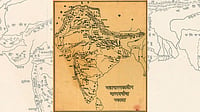For the first seventeen years of India’s independence, Jawaharlal Nehru, a man of infinite paradoxes—a moody, idealist intellectual who felt an almost mystical empathy with the peasant masses; an aristocrat, accustomed to privilege, who had passionate socialist convictions; an Anglicised product of Harrow and Cambridge who spent over 10 years in British jails; an agnostic radical who became an unlikely protege of the saintly Mahatma Gandhi—was India. Upon Mahatma Gandhi’s assassination, Nehru became the keeper of the national flame, the most visible embodiment of India’s struggle for freedom. Incorruptible, visionary, ecumenical, a politician above politics, Nehru’s stature was so great that the country he led seemed inconceivable without him. India has in many respects moved on, but Nehru remains a compelling figure, irresistible to historians, biographers and politicians alike.
Forty-six years after his death, Nehru’s niece Nayantara Sahgal, author of several fine novels and a coruscating book on Indira Gandhi, has given us a fascinating if slender volume, Jawaharlal Nehru: Civilizing a Savage World. There are references to all the principal pillars of Nehru’s legacy to India—democratic institution-building, staunch pan-Indian secularism, socialist economics at home and a foreign policy of non-alignment. It is the last that is her principal concern.
It was once said that India did not have a foreign policy, Nehru did: so completely was our nation’s place in the world identified with him. Nehru developed a role for India on the world stage based largely on its civilisational history and moral standing, making India the voice of the oppressed and the marginalised against the big power hegemons of the day and a force for peace in the midst of the Cold War. This gave the country enormous prestige across the world for some years, but the humiliation of the 1962 war with China demonstrated its limitations. Nehru died a broken man, his spirit shattered amidst the wreckage of ‘Hindi-Chini bhai-bhai’.
Sahgal writes with undisguised affection and admiration for an uncle she saw as “a special shining being, than whom all men were lesser men”. She outlines Nehru’s worldview and his internationalist convictions, drawing from his correspondence and speeches but also from more personal sources—her own recollections and those of her mother, Vijayalakshmi Pandit, who served her brother in a number of key diplomatic assignments. (Pandit’s letters to and from Moscow, Washington and London paint an impressive portrait of the sophisticated internationalism of this remarkable pair). Sahgal also defends Nehru fiercely from charges of temporising over Tibet and Goa, and offers a sympathetic reading of his actions and statements in the lead-up to the disastrous China war. There is no pretence of objectivity; Sahgal is uncritical of Nehru, but her writing is too thoughtful and intelligent to be dismissed as mere hagiography.
The book offers many delights. There is an evocative description of the family atmosphere at Anand Bhawan, illuminated with extracts from letters exchanged amongst several of the hyper-articulate Nehrus. There are delightful asides, such as Pandit’s account of a conversation with the devout US Secretary of State John Foster Dulles: “He would have had me believe the Lord himself had blessed America’s stand.... It was tough explaining that my Prime Minister disagreed with the Lord.” There is Nehru worrying in a letter to his sister about his first visit to the US: “Which facet of myself should I put before the American public—the Indian or the European?.... I am inclined to think that the best preparation for America is not to prepare and to trust to my native wit and mood of the moment.... I go there to learn more than to teach.”
And yet there is curiously little about the actual visit, or Nehru’s two subsequent ones, including his disappointing encounter with Kennedy. Nehru’s views of the US were complex and nuanced, and it is striking that he drew daily inspiration from a bronze cast of Abraham Lincoln’s hand, which he kept in his study. Here, however, Sahgal only skims the surface of her subject. She is more comfortable with restatements of the extent to which “Nehru’s active role as mediator and peacemaker in international crises was seen as symbolising reason, sanity and the common longing for a world without war.” This is true, but it’s not enough. Sahgal could have done more to flesh out the case for Nehru as a hard-headed defender of the national interest and not merely the woolly-minded idealist depicted by his critics.
The book offers some rare revelations, none more so than a startling message from nuclear physicist Robert Oppenheimer, one of the fathers of the atom bomb, urging Nehru not to sell thorium to America for fear of the deadly uses to which the US intended to put it. Amongst its surprises are a New York Times editorial of 1959 supporting Nehru on village cooperatives and an assassination threat to Nehru from a distraught Bengali signing himself “A Nathuram Godse”. Perhaps more touching are descriptions of Nehru’s concern for the living conditions of his domestic staff and of his openness: “What you saw was what he was. What he said was what he meant.... Transparency was his public and private style.” (A style, alas, that few of today’s politicians emulate.)
Nehru was that rare kind of leader who is not diminished by the inadequacies of his followers, let alone his own limitations. India’s foreign policy has changed in important respects today, and the multi-alignment of 2010 is not the non-alignment of 1960. Yet our international role remains deeply rooted in the vision, character and principle of one man, Jawaharlal Nehru. This alone makes this book well worth reading.

























